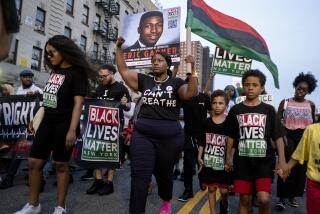Coverage of Youth Crime Promotes Fear, Study Says
- Share via
Although national crime rates have plummeted in recent years, a report to be released today argues that violence and crime dominate media reports, creating unwarranted fear and reinforcing inaccurate images of young people and ethnic minorities.
Newspaper and television stories are more likely to depict African Americans as criminals, the studies say, and to portray young people as violent and connected with gangs, contrary to police data. At the same time, the authors contend that the media also underreport instances in which minorities and youths are crime victims.
The result is that average Americans increasingly support tough laws to crack down on youths, who are viewed as out of control.
“Young people today are less likely now than in [past generations] to take drugs, drink alcohol, get pregnant as teenagers or assault each other in schools, yet we’re so much harder on them,” said Vincent Schiraldi of the Justice Policy Institute, which was a co-author of the report.
“I think now there’s a special responsibility on the media to address these issues.”
Dori Maynard, of the Maynard Institute for Journalism Education in Oakland, said she does not believe that media outlets set out to distort reality. But she agrees that the media could do better.
“I don’t say that they’re ill-meaning; they just don’t see it.”
“Historically, those of us who watch journalism and diversity know that there’s been a problem,” Maynard said. “As we become an ever more complex society, we need the media to help us understand ourselves if we are to create a more coherent public policy.”
The report, “Off Balance: Youth, Race and Crime in the News,” surveyed trends in the results of dozens of studies, one of which examined articles in the Los Angeles Times. Among the findings:
* Although homicides by juveniles dropped 68% from 1993 to 1999, most people believe youth crime is on the rise.
* In 1998, violent crime by youths reached a 25-year low, according to the Census Bureau’s National Crime Victimization Survey. But nearly two-thirds of those responding to a poll said they believed juvenile crime was growing.
* Homicide news coverage increased by 473% on network television from 1990 to 1998. Yet, nationally, homicide arrests dropped 33% over that same period.
“The majority of Americans who get their information on which to base decisions--whether it’s voting decisions or what policies to support or what to be afraid of in the world--get that information from the news,” said Lori Dorfman of the Berkeley Media Studies Institute, a co-author of the report. “When the news limits the information that people get, that leads to distortion.”
The 52-page report does not use new data, but compiles the results of 77 studies conducted from 1910 to 2000 on violence, youths--people under age 18--and race in television, news weekly magazines and newspapers.
The results show that television coverage tends to be more out of line with actual crime than coverage in print news outlets.
The report is to be released today in Washington.
“These studies have never all been assessed together,” Dorfman said. “You need to take a step back and look at whether there are trends and patterns in the data that are consistent.”
One dominant theme in the data showed that the media disproportionately cover the most unusual crimes. A study that examined five years of articles about homicides in the Los Angeles Times found that the least common murders--those committed by strangers and where killer and victim are of different races--received the most coverage. In reality, crime data show, many murders involve people who know each other and are of the same race.
A 1993 study in California found that half of television news stories concerning children or youths involved violence, but only 2% of young people in the state were crime victims or perpetrators.
Experts say such coverage leads viewers and readers to fear situations that actually are unlikely.
“What does that lead to?” asked Franklin D. Gilliam, a political science professor at UCLA whose study is included in the report. “It leads to public policy prescriptions that say these are bad kids and the way to deal with them is punitive.”
Last year, more than 60% of California voters approved Proposition 21, which made it easier to try youths as adults when they are accused of serious crimes. Since 1992, more than 47 states have made their juvenile justice systems harsher, the report said.
Sig Gissler, former editor of the Milwaukee Journal and now a journalism professor at Columbia University, agreed that news reports often don’t contain enough context.
“This feeds misperceptions, and scares the pants off people,” Gissler said. “It’s not in the name of being do-gooders [that things should change] but in the name of accuracy.”
More to Read
Sign up for Essential California
The most important California stories and recommendations in your inbox every morning.
You may occasionally receive promotional content from the Los Angeles Times.










